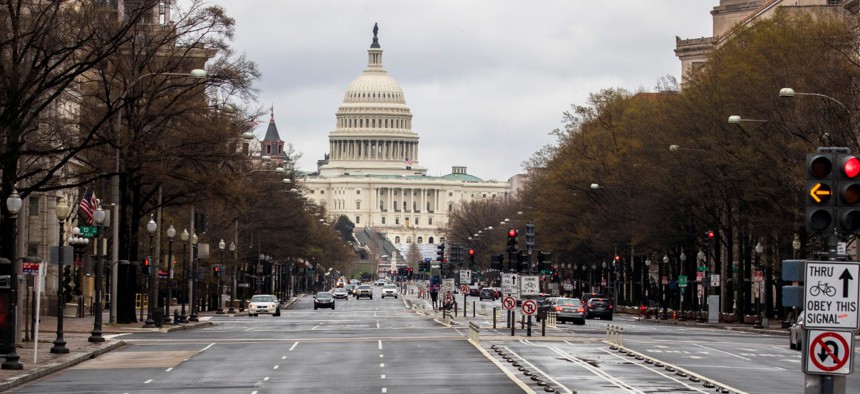Stimulus Deal Gives Agencies $340B, Helping to Boost Telework, Office Cleaning and Hiring
A Senate aide says other House-backed provisions to give feds more benefits did not make into the final deal.
Federal agencies will see a $340 billion boost for operations and response efforts in the face of the novel coronavirus under a more than $2 trillion stimulus package Congress is expected to pass this week, which the Senate passed late Wednesday after painstaking bipartisan negotiations with the White House.
Lawmakers and their aides were still ironing out the legislative text of the bill Wednesday evening, meaning some of the final details were unclear until the final moments before senators voted. House Democrats had pushed for a suite of new benefits for federal employees to be included in the package, but the Senate declined to include most of them. Earlier in the day, the Senate Appropriations Committee put forward the emergency supplemental funds agencies will receive as part of the plan.
The departments of Agriculture, Interior, and Health and Human Services would receive funding to hire new staff. The Housing and Urban Development Department, Securities and Exchange Commission, and Commodity Futures Trading Commission would have hiring flexibilities to expedite the recruiting process for the duration of the coronavirus emergency. USDA, Interior and HHS, as well as the departments of Justice, Homeland Security and Veterans Affairs are in line for appropriations to support overtime for employees working on coronavirus response. The Transportation Security Administration and Bureau of Prisons would each see $100 million for those costs as well as for new personal protective equipment and cleaning supplies for workers.
VA, FBI, the Drug Enforcement Agency, the Marshals Service, Defense Department, Forest Service, HHS and others would also receive tens of millions of dollars to purchase personal protective equipment.
Dozens of agencies across government would see millions of dollars to improve their telework capacity, through network expansions and software license purchases.The Office of Personnel Management would receive $12 million to expand telework, including digitizing the usually paper-based retirement application and case management process. The General Services Administration would receive nearly $300 million, most of which would go toward deep cleaning and enhanced screening at federal buildings as well as providing for unanticipated space requirements across government.
HHS would see a total of $140 billion, the largest infusion at any single agency. Most of that money—$127 billion—would go into the Public Health and Social Services Emergency Fund to reimburse hospitals and health care providers, replenish the strategic national stockpile with equipment such as ventilators, and fund vaccines and therapeutics, among other purposes. DHS would receive about $46 billion, most of which would go to the Federal Emergency Management Agency’s Disaster Relief Fund.
The Transportation Department would receive $31 billion, primarily to provide grants to transit providers and for airports to maintain operations during the current plunge in passengers. HUD would see a $17 billion influx for various housing and development programs. The Veterans Affairs Department would receive nearly $20 billion, mostly going toward boosting health care services at its facilities. As of Wednesday, VA had confirmed 365 COVID-19 cases across its network. The bill would provide $2 billion for veterans to receive private sector care, though the department announced on Wednesday it would freeze its reimbursed private care program expanded under the 2018 Mission Act to protect veterans from exposure and prevent private hospitals from being overwhelmed.
USDA, the State Department, the U.S. Agency for International Development and the Peace Corps would receive hundreds of millions of dollars to bring home thousands of employees and volunteers currently stationed overseas.
Overall, Congress would provide agencies with $340 billion in emergency supplemental appropriations, far exceeding the White House’s request of $46 billion.
Earlier this week, House Democrats put forward their own stimulus plan that would have provided the new perks for the federal workforce. It would have made federal employees required to work during the crisis eligible to receive up to $2,000 in reimbursement for child care costs per dependent child, and required any employee with a telework agreement in place to work remotely through the end of the year. Employees who are directly treating individuals diagnosed with COVID-19, or those with “frequent, unavoidable contact” with the public, including Transportation Security Administration screeners, would have been eligible for hazard pay. The measure would have also ensured employees whose offices are closed, but who also cannot telework, are eligible for paid “weather and safety leave.”
The House Democrats had also included provisions to revoke three Trump-signed executive orders and one memorandum that sought to weaken federal employee unions and hasten the disciplinary process. It would have provided a $25 billion cash injection to the Postal Service and forgiven $11 billion of its public debt. President Trump and Republican lawmakers have criticized Democrats for including provisions they viewed as extraneous to the immediate crisis, but the final deal provided USPS with a new $10 billion line of credit.
While the details had not yet fully circulated around the Capitol by Wednesday evening, a Senate Democratic aide said it appeared that most of the House’s workforce provisions were not included in the final deal. In the final version of the agreement, most of those proposals were indeed left out.
The House is expected to vote on the measure Friday, and Trump is expected to promptly sign it.
This story has been updated to reflect the Senate's passage.








